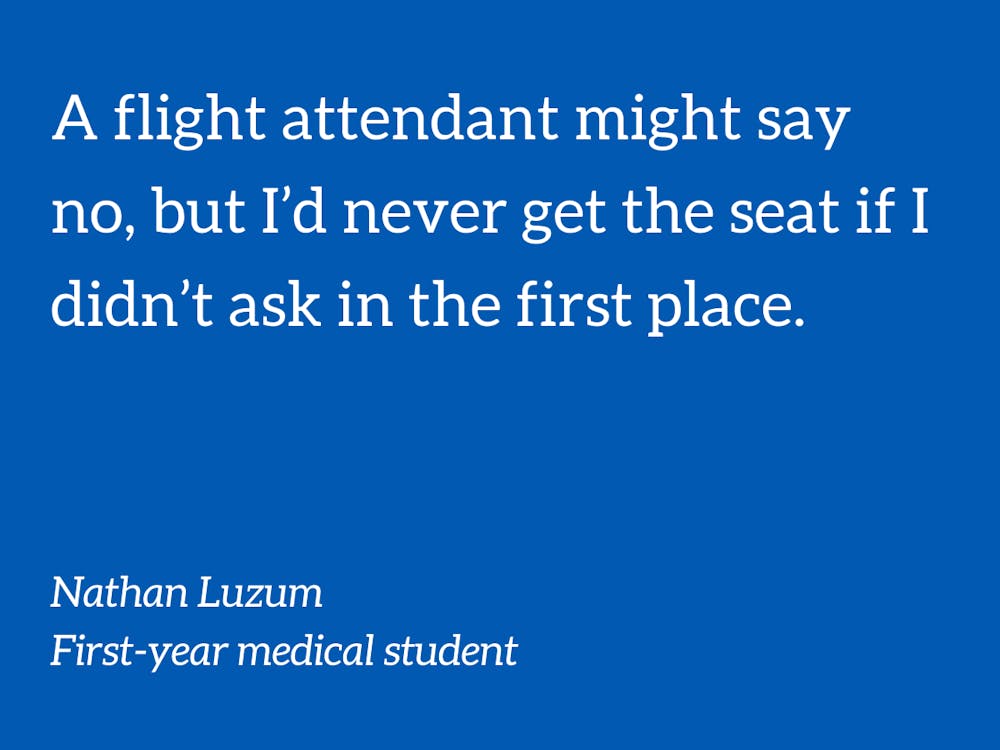Airports hold a special place in my heart—no other setting features life’s rich tapestry laid out in such a chaotic and amusing fashion.
I was reminded of this several weeks ago when flying from Kansas City to RDU, surrounded by a number of reliable characters who are somehow present at every airport I’ve ever been to. There’s the loud talker, who for some reason chooses the airport as the best venue to shamelessly put their messy life drama on display, the overdressed businessman with an inflated sense of self-importance (which always makes me think of this), and the list goes on.
Despite my enjoyment of people-watching at airports, boarding airplanes is one of my least favorite activities. It falls somewhere between ordering at Chipotle where everything always seems too loud, and calling any insurance company for any reason. During my flight back to Durham, I had a layover with plane change, meaning that I enjoyed the enthralling adventure of boarding an airplane not once, but twice, in a single day.
Naturally, this process has its own bizarre rituals. Ahead of me are the forlorn lovers—separated by virtue of having A53 and B6 on their boarding passes, cursed by separate Southwest.com accounts—pulling down their masks to steal a kiss before taking their respective places in line. Fortunately, five minutes later, they reunite in Row 8, and all is right with the world.
My airline of choice is Southwest. Its boarding process involves dividing people into three groups (A, B and C), further subdivided into numbers (1-60) dictating the order in which people can board. There’s always the elementary-school feeling of lining up to get on the plane, and the people asking everyone around them to compare numbers doesn’t help. Because, by God, they got A23, and they’ll be damned if A24 can sneak in ahead of them. But no seats are assigned, so everyone can more or less sit wherever they want. For those interested in the incredibly niche field of airplane boarding research, studies suggest that random boarding with no assigned seating ends up being faster than more traditional methods, like boarding back to front. Personally, I think the fastest boarding method would just be to release a bear in the terminal, but airline executives have largely ignored my emails on the subject.
Anyway, that’s all to say that when I boarded, seating was a free-for-all. The first few aisles are always taken, so my eyes automatically scanned farther back in the plane, which was filling up quickly. Hope of snagging an aisle seat was evaporating. But then I realized something: the smiling flight attendant a couple rows ahead of me was standing in a completely empty row. Everyone else had simply walked by her in an effort to find seats toward the rear. I saw an opportunity.
Let me just say that I have a lot of respect for flight attendants. If sitting on an airplane for a couple short flights is irritating to me, then I can only imagine what it feels like to stand in one for hours on end, day after day, explaining that Sprite isn’t available and you’re stuck with 7 Up. I felt apprehensive about asking her if I could have the seat, but I built up the courage and decided to shoot my shot with a polite inquiry. With a cheery “of course!” she moved a couple rows, and I scored the prime aisle seat. As the travelers who had boarded before me continued their fruitless search for seating, they cast jealous glances back in my direction. I felt invincible.
During my layover, I thought about the challenge undertaken by Jia Jiang, Fuqua ‘09. To overcome his fear of rejection, Jiang started a blog where he filmed himself making 100 (bizarre, yet legal and ethical) requests of strangers. One day, he knocked on some random person’s door and asked if he could plant a flower in their backyard. Another time, he went to a Krispy Kreme and wondered if they could make donuts interlocked like Olympic rings. Jiang even asked to use the intercom on a Southwest flight. Over his 100 days of rejection therapy, he received many nos but also a surprising number of yeses, realizing in the process how often people reject themselves and their own ideas before even making a request. A flight attendant might say no, but I’d never get the seat if I didn’t ask in the first place.
It was with this newfound motivation and sense of adventure that I boarded the second plane. My boarding number was approximately the same as last time, so a similar scene greeted me: the first half of the plane was full, and aisle seats toward the back were rapidly disappearing. But sure enough, a flight attendant was perched in an empty row in the middle of the plane. I knew my plan. As others shuffled past, I once again stopped to make my request. Like her predecessor, she happily agreed and shuffled to another row. I sat down and reflected on Jiang’s challenge. It might not be a box of Olympic-themed donuts, but at least I had an aisle seat.
Nathan Luzum is a first-year medical student. His column runs on alternate Thursdays.
Get The Chronicle straight to your inbox
Signup for our weekly newsletter. Cancel at any time.

